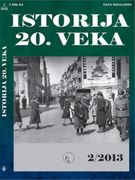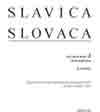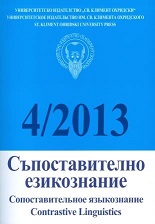
Gróf Teleki Géza és a Művészház erdélyi kapcsolatai
Essay on Count Géza Teleki's activities of art patronage with particular consideration for the "Művészház" (Art House) circle.
More...We kindly inform you that, as long as the subject affiliation of our 300.000+ articles is in progress, you might get unsufficient or no results on your third level or second level search. In this case, please broaden your search criteria.

Essay on Count Géza Teleki's activities of art patronage with particular consideration for the "Művészház" (Art House) circle.
More...
Three prose poems by Romanian surrealist poet Ionathan X. Uranus (Marcel Avramescu), translated by Imre József Balázs.
More...
The article analyses the was out from the death camps in Jasenovac and Stara Gradiška in 1941-1945. Author crytisise the earlier works of the Yugodslav historiography, which mosly focused its works on the estimations of number of the victims killed in the camps, or decsribing the activities of the illegal Communist organisation inside the camp. All other ascpets of the camps existance and daily routine, including the cases of the detainees which were sent out from the camops, were researched and desribed as rare or random case.
More...
The author highlights several problemsthat the Republic of Serbia (FRY, Serbia-Montenegro) has encountered on its way to permanent membership of the Council of Europe. It has had to cope with numerous barriers, in many aspects unique. The Federal Parliament adopted the Constitutional Charter of the State Union of Serbia and Montenegro on February 4th 2003, by which act the Federal Republic of Yugoslavia had ceased to exist. The Committee of Ministers invited the State Union of Serbia and Montenegro tobecome a full fledged member of the Council of Europe. The accession finally took place on April 3rd, but conditioned with a specific, unprecedented dual monitoring procedure. During the decade that followed, first Serbia-Montenegro, and from then on Republic of Serbia as the successor state, has often been forced to defend its interests concerning territorial integrity and sovereignty, while participating in the work of the CoE and its bodies. The most common issues involved Kosovo and Metohia, national minorities and religious communities rights, as well as the cooperation with the ICTY. The most important document for Serbia adopted by the PACE was a resolution calling for international and local investigations into illicit organ trafficking in Kosovo, based on a report written following a two-year investigation by Swiss rapporteur Dick Marty. Serbia chaired the Committee of Ministers for a six-month term from May to November 2007. After all the hardships ithad to endure during the first ten years of its CoE membership, the Chairmanship came as a special honour and a long awaited recognition of the commitment of the Republic of Serbia to fundamental European values, democracy, respect for human rights and the rule of law.
More...

Yugoslavia’s normalisation of the relations towards West, after the clash withe the Stalin and Infrombureau1948, led to the stronger presence of the western mass culture within the country. Politcal solution after the 1953 crises over Trieste, led to normalisation in the relatins with Italy, and influneced popularity of the Italian culture in Yugoslavia. Especially present and popular among the Yugoslav public was Italian music and cinematography. Italian fims were extremlypopular and the public crowded the cinemas. Musical hits from San Remo festival, influenced development of the Yugoslav popular music. Most popular notables of the Italian art and mass-culutre were known in Yugoslavian public, and even the Yugoslav president and Communist Party leader Tito „communicated“ with them. In his luxury object in Brioni islands, Tito hosted several of the Italian celebrities of the time, such as Mario del Monaco, Sofia Loren, Carlo Ponti, Gina Lolobrigida, Alberto Moravia, etc. Global popularity of the Yugoslav leader, make him an atractive host, and although private meetings, the stream of the visits of the Italian celebrities showed another step in opening of the Yugoslavia towards West, thus balancing between two Cold War blocs in Europe.
More...
Abuse of psychiatry for political purposes appeared massively in USSR and other communist countries since the end of 50s, especially in terms of relative liberalization and de-Stalinization, as well as a need to conceal the real number of political convicts. In socialist Yugoslavia this phenomenon became particularly common since the middle of 70s, with the strengthening of civil sector, signing international declarations about human rights and the regime`s wish to present itself as a country of liberal socialism after the reforms of the 50s.Criticism of the regime as well as expressing liberal and critical attitudes and opinions were the reason for declaring people dangerous for the environment without any documents or proofs, instead of imprisoning them for political offence. In this way the real number of political convicts was “hidden”, and this kind of abuse was a mean of social and political control in the hands of the repressive apparatus. The term “dangerous for the environment” was rather exploited, and its broad interpretation alluded whatcan be subsumed under ideologicalpolitical diversion.
More...

Upon its creation, in late 1918, the Kingdom of the Serbs, Croats and Slovenes, had a three different financial and currency systems. Those were of Kingdom of Serbia, Kingdom of Montenegro and Austro-Hungarian Empire. On its territory there was also a huge amount of the occupation currencies, those of the Bulgarianad the Germany. Mutual state anticipated the creation of the mutual currency. But except for the choice of the currency for the new Kingdom, it was necessary to establish the relations between the existing currency, so that it should be used for the exchange. Central issue was the relation and the exchanging rate between the Serbian Dinar and Austro-Hungarian kruna. The accepted solution and rates were matter of the debates and disputesin economical and political circles in Kingdom of SHS (Yugoslavia) and continued until nowadays, almost a century after. This article provides closer look into different economical standpoints and opinions of the time, as well as the political standpoints and financial analyses of the values ofthe two currencies during the period of the exchange.
More...
The subject of our monograph is a polemical-apologetical manuscript miscellany, which is located in the National Library of Ukraine, Institute of Manuscripts, collection № 312, shelfmark Соф 104 (105). Originally it belonged to the library of St. Sophia’s Church (the Church of the Holy Wisdom). It was probably written in the late 16th century on the territory of the Kievan Metropolitanate. It is written on paper with dimensions 31 x 20 cm, has described 133 folios of written text (immediately followed by 4 blank folios), the title page is missing. The manuscript is written in semi-uncial Cyrillic script of uniform appearance. It is written in the Church Slavonic language of the Russian redaction with a recognizable influence of the Middle Bulgarian orthography. The manuscript miscellany was compiled in response to the Reformation movement and its ideas, especially as regards the issue of transubstantiation of bread and wine into the Body and Blood of Jesus Christ as well as the question of the sacrificial nature of the Eucharistic liturgy. Besides, it deals with some other theological differences between Protestants and the teaching of the Catholic and Orthodox Churches, especially in the theology of liturgy. The editor made a selection of tractates by the Church Fathers and Theologians, mostly those of Eastern tradition that support his opinion. He also added examples of prayers and two little-known liturgies (the Liturgy of St. James and the Liturgy of St. Peter). At the beginning he placed a comprehensive preface explaining the motives for the compilation of the manuscript and partly also the reason for choosing the particular tractates. Of particular interest here is the fact that the author refers to the testimony of other Churches, the most important one being the testimony of the Church of Rome. The preface is an interesting testimony about the relations between Christians of various denominations in the Kievan Metropolitanate, and it is an especially important source on the relationships between Latin and Byzantine Christianity in the Polish-Lithuanian commonwealth. Having considered certain formulations in the preface and the content of the miscellany we can infer that the author was of the Byzantine rite. His vocabulary and theological attitudes show that he attended a school of the Latin rite, or a school of the Byzantine rite, which taught according to Western models and in the Latin language. Since there is no mention of the Union of Brest (1595-1596), we may suppose that the preface (and hence the whole miscellany) was written prior to the conclusion of the Union.
More...
REVIEWS AND ANNOTATIONS
More...
REVIEWS AND ANNOTATIONS
More...
REVIEWS AND ANNOTATIONS
More...

The process of the rapid proliferation of various terminological systems during the past decades creates the need of developing a theory of terminological systems as one of the ways of bringing order into this process. The article examines some basic concepts and principles of such a theory with a view to developing a methodology of constructing such systems. Four groups of problems are discussed: the essential characteristics of terminological systems and their description, their elements and their interrelationship and the methodology of linguistic construction of such systems. Introduced are the concepts of the pair “term-definition“ as an element of the terminological system, transformed definition and taxonomic network ordered graph of the structure of the terminological system.
More...



